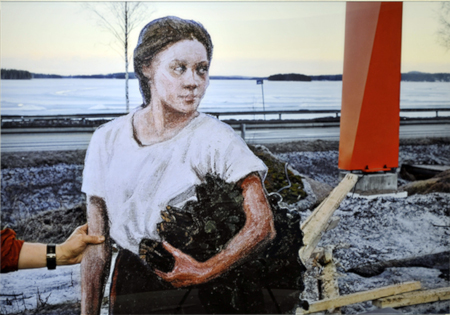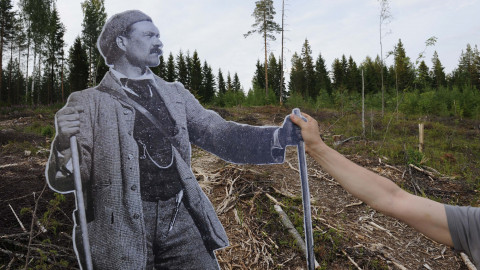Research and Publications
Research
Research facilitation is one of a museum’s principle services. The Jyväskylä Art Museum focuses on research related specifically to Central Finnish artists or to Central Finnish visual art in general. The museum acts as an information source, a communicator and promoter of research material for the public through exhibitions, books, internet publications, lectures as well as through guided tours and other public relations activities.
The museum’s research strategy for the years 2007–2015 was completed at the end of 2006. The strategy is updated every five years. Our goals include the building of project related networks for scientific research between universities, museums and independent researchers. In particular, the museum has collaborated with the University of Jyväskylä’s department of Music, Art and Culture Studies.
The documentary work executed at the museum, such as artist interviews and the basic information of artworks and artists in database of collections, is known as fundamental research. Research related to the conservation and preservation of artwork is obtained through a purchased service because the Jyväskylä Art Museum does not have their own art conservator on premises. Visitor research is surveyed at least once every year.
The museum maintains and accumulates a collection of artworks, photos and documentation materials, newspaper articles, and a library specifically for research material use. The databases and archives are used by the museum’s own personnel, as well as by individual researchers and thesis writers. Activities and events organized by the museum have also been important research subjects.
For more information: head curator Tiina Koivulahti, tiina.koivulahti(at)jyvaskyla.fi
Research Projects
Uuno Alanko – searcher of truth and beauty
Uuno Alanko (1878–1964), was known as Uno Alanco until 1925, and was an independent and controversial artist, but also a significant artistic influencer of his time. He was an engineer, architect and painter who enjoyed a long career as an artist and art teacher. Alanko often painted Central Finnish landscapes, interiors and flora subjects between 1918–1950.
Yrjö Saarinen’s art and life
This study focuses on the expressionist colourist art of Yrjö Saarinen (1899–1958) who was born in the Jyväskylä region and who painted in both Jyväskylä and Hyvinkää. The web-articles (texts in Finnish only) look at Saarinen’s life and artistry, his use of colour and his role in the Finnish art scene in the 1930–1950s.
Contemporary art of Central Finland
The subject of this study was related to landscape, nature and cultural environments in contemporary art of Central Finland (1975–2017). The results of this research produced several articles and 48 presentations of artwork in the on-line exhibition space Maisema, ympäristö ja luonnos -verkkonäyttelyyn (Landscape, environment and sketches – an on-line exhibition), which was a joint collaboration between the Jyväskylä Art Museum, the Museum of Central Finland and the Finnish Craft Museum. Contemporary art dismantles and reinforces two aspects of the landscape concept: on one hand it attempts to approach an immediate sensorial experience and on the other, to ponder the cultural nature and depiction of landscape.
Art in the 1970–1990
The subject of this study was Finnish art in the 1970s –1990s as well as how art in the Central Finnish area is visible in writings about domestic art. This research project and webpage are part of the Jyväskylä city art collection exhibition, What Does Time Look Like.
One Hundred Years, A Thousand Meanings, 2016–2017
The One Hundred Years, A Thousand Meanings research project and exhibition presented significant Finnish art through different interpretations. The Association of Finnish Fine Arts Foundation’s member’s collection, of approximately 14 000 artworks, served as the material base for this project. From this collection, 73 artworks were chosen as subjects of research. These subjects were paintings, sculptures, photographs, prints, arts and crafts from the late 19th century up until the 2010s.
The research mapped out the perspectives of critics of the time, art historians, researchers and even the artist’s own interpretations of the artwork. Research at the museum was lead by PhD Seija Heinänen and MPhil Marja-Liisa Rajaniemi.
Before the opening of the exhibition, interpretations of the art work were collected from approximately one hundred people, based on images of the artwork. Seniors, school children, exchange students, members of special groups and the Art and Culture Companions were part of this project. The interpretations were recorded in voice recordings and/or videos. The exhibition visitors were also invited to write down their own interpretations both in the museum and on the project website. Interpretations were also performed by students in the department of arts and culture at the University of Jyväskylä, as part of their studies in the spring of 2017. In addition, professors and staff of various departments at the University of Jyväskylä wrote six articles in which they interpreted the content of the exhibition’s artwork. They appeared in the e-book Sata vuotta, tuhat tulkintaa. Link to the e-book: http://www.tuhattulkintaa.fi/nayttelyjulkaisu/ (in Finnish)
The exhibition website www.tuhattulkintaa.fi (mainly in Finnish) includes interpretations from researchers, exhibition visitors and public workshops along with videos of artwork interpretations. Interpretations were made for 45 artworks http://www.tuhattulkintaa.fi/teokset/ These artworks are from the collections of the Alfred Kordelin Foundation, the Fortum Art Foundation, the Gösta Serlachius Fine Arts Foundation, the Signe and Ane Gyllenberg Foundation, the Art Foundation of Merita and the UPM-Kymmene Cultural Foundation.
The One Hundred Years, A Thousand Meanings exhibition (June 9th – October 8th, 2017), the related research work along with the interpretations collected and recorded in this project, were part of the national Suomi100 programme celebrating Finland’s 100th anniversary of independence.
Pekka Halonen, Kivikoski, 2016
The spring of 2016 presented another occasion to pursue more research in connection to the extensive 2010 project and Jyväskylä Art Museum exhibition Landscape Experiences and the Scenic Spots (Maisemapaikka) webpage. The students of the cultural studies department at the University of Jyväskylä chose artist Pekka Halonen’s landscapes and paintings made at the Kivikoski rapids as the focus of their primary field study. The Jyväskylä Art Museum was also part of the field study organization. Seija Heinänen lectured to the students about Halonen’s art and relationship to nature. She also acted as an informant as the students were planning their projects.
Graphica Creativa, 2015–2016
Artwork and their background from the Jyväskylä Art Museum’s n Graphica Creativa exhibition which opened in October 2016 were also subjects of research. The theme for this international printmaking triennial was contemporary printmaking and art history, presenting a cross section of the history of printmaking from the 16th to the 19th century. Classic artists in this exhibition included Albrecht Dürer (1471–1528), Jacques Callot (1592–1635), Anton van Dyck (1599–1641), Rembrandt Harmenszoon van Rijn (1606–1669), Giovanni Battista Piranesi (1720–1778), Francisco Goya (1746–1828) along with more recent artists such as James Ensor (1860–1949) and Oskar Kokoschka (1886–1980).
Japanese woodcut prints along with work by contemporary artist and Finnish printmakers from the 1960s to 1980s were also subjects of research for this project which looked at their relationship to Art History, masters and their works.
The exhibition catalogue A Present to the Past (edited by Seija Heinänen and Jukka Partanen) was also published on-line. Link to the webpage publication:
https://issuu.com/jyvaskylantaidemuseo/docs/gc-julkaisu___sivut
Central Finnish art in the 1950’s and 1960’s, 2013–2014
The research for this project focused on Finnish art from the 1950’s and 1960’s including research on Central Finnish art and life during that same period, as well as the activities of the artist associations and regional artists. Exhibitions and the artists’ travelogues were also of interest, along with local and national discussions on art.
The foundation for this research project was obtained from the City of Jyväskylä’s art collection, and the Museum of Central Finland’s accumulated archives of newspaper articles (approx. 1 200 pages) concerning local artists from that period. Based on this research data, the exhibition Ehtiihän sinne Pariisiin myöhemminkin / Paris can wait (December 19th, 2014–May 24th, 2015) was organized in the Jyväskylä Art Museum and produced on an internet website.
Internet website (in Finnish): http://ehtiihanpariisiin.keskisuomentaide.fi/teokset/
Scenic Spots, 2010–2012
This webpage shares observations and changes in four different landscape locations. The landscape locations were chosen according to three artists’ painting sites, and one rock painting site. By comparing paintings and both photographs and videos of the landscape taken in 2010, and by examining research data, it is possible to interpret local history, cultural impact, changes in landscape, and the relationship between the landscape painted by the artist and the present landscape.
Important regional and national significance were part of the criteria for choosing these locations. In a historical context, the period of study for the landscapes ranges over approximately one hundred years, whereas the Saraakallio rock paintings are estimated to be 3500 to 7000 years old.
Scenic spot was a research project that produced material for an online exhibition. This project was a collaborative production between the Jyväskylä Art Museum, the Department of Art and Culture Studies at the University of Jyväskylä and Centre for Economic Development, Transport and Environment (ELY-Centre) for Central Finland.
Scenic spots are:
Huhkojärvi in Keuruu (formerly known as Jamajärvi) the shore landscape shown in Akseli Gallen-Kallela’s painting Kullervo’s Curse (1897–1899).
Kymönkoski in Viitasaari the stream pool, which was painted by Wilho Sjöström into his painting Cloudy Day in 1902.
Kivikoski in Kuhmoinen the river landscape, where Pekka Halonen painted his Summer Sports painting in 1922.
Saraakallio in Laukaa two rock painting areas.
Scenic spots / Maisemapaikka website (in Finnish): http://www.tunnemaisema.fi/maisemapaikka/
Landscape Experiences, 2007–2011
This research topic focused on the observation and the construction of meaning about landscape as well as about how our relationship to landscape has changed over time. Starting-point is to think and perceive the environment in terms of visual landscape, i.e. scenery and views. Project focused on a comparison between Akseli Gallen-Kallela’s and Pekka Halonen’s landscape paintings from Central Finland between1880–1930, and contemporary artists’ landscapes and work related to environmental themes.
The Jyväskylä Art Museum coordinated the collaborative project with four main universities (Jyväskylä, Helsinki, Joensuu, Turku/Pori) and one university of applied science (Tampere) with a team of professionals from different fields related to landscape and the environment.
In 2010, the research group, together with guest, Malcom Andrews, a landscape and literature research professor from the Kent University, organized a two-day research workshop. The group members all contributed articles to the Tunne maisema (Landcape Experiences) book.
Landscape Experiences -exhibition, based on the research data, was organized at the Jyväskylä Art Museum in 2011.
Publications
in Finnish
Publications of the Jyväskylä Art Museum
Theses related to the Jyväskylä Art Museum’s operation and activity

Juha Suonpää, The Sauna Girl, Konginkangas, 2011, photographic essay ”I followed in Akseli’s footsteps”. The Jyväskylä City Art Collection. Photo: Jari Kuskelin. Juha Suonpää has identified the precise location and landscape of Akseli Gallen-Kallela’s The Sauna Girl painting (1904) and taken picture in spring 2011 from the same spot placing cardboard puppet of Gallen-Kallela’s model in the picture.

